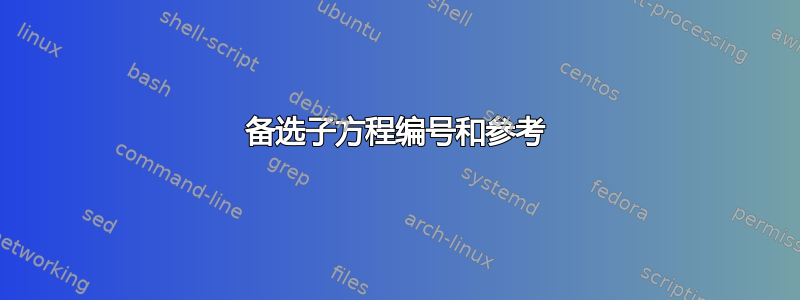
我知道如何将一组方程编号为子方程:
\documentclass{article}
\usepackage[T1]{fontenc}
\usepackage[utf8]{inputenc}
\usepackage{amsmath}
\begin{document}
Some text here
\begin{subequations}\label{eq:full}
\begin{align}
y_1 &= f_1(x) \label{eq:first} \\
y_2 &= f_2(x) \label{eq:second} \\
y_3 &= f_3(x) \label{eq:third}
\end{align}
\end{subequations}
\dots and now I can reference the full set as equations~(\ref{eq:full})
and for example the first as equation~(\ref{eq:first}).
\end{document}
这使:
是否可以将方程式标记为以下形式:
...并使对单个方程的引用保持不变?(或者可能将“全局”的改为1a--c,不确定)。
答案1
这是可以做到的,但是我给环境起的名字应该可以澄清我的看法。;-)
\documentclass{article}
\usepackage[T1]{fontenc}
\usepackage[utf8]{inputenc}
\usepackage{amsmath}
\usepackage{environ}
\makeatletter
\newsavebox{\horriblesubequationsbox}
\NewEnviron{horriblesubequations}[1]{%
\setbox\horriblesubequationsbox=\vbox{
\hsize=\dimexpr\linewidth-8em\relax
\begin{subequations}
\renewcommand{\theequation}{\alph{equation}}
\vspace*{-\baselineskip}\vspace*{-\abovedisplayskip}
\noindent\strut
\begin{align}
\BODY
\end{align}
\end{subequations}
\addtocounter{equation}{-1}%
}%
\begin{equation}\label{#1}
\hspace*{4em}\left.\vcenter{\unvbox\horriblesubequationsbox\unskip}\right\rbrace
\end{equation}
}
\makeatother
\begin{document}
Some text here
\begin{horriblesubequations}{eq:full}
y_1 &= f_1(x) \label{eq:first} \\
y_2 &= f_2(x) \label{eq:second} \\
y_3 &= f_3(x) \label{eq:third}
\end{horriblesubequations}
\dots and now I can reference the full set as equations~(\ref{eq:full})
and for example the first as equation~(\ref{eq:first}).
Some text here
\begin{horriblesubequations}{eq:full+}
y_1 &= f_1(x) \label{eq:first+} \\
y_2 &= f_2(x) \label{eq:second+} \\
y_3 &= f_3(x) \label{eq:third+} \\
y_4 &= f_4(x) \label{eq:fourth+}
\end{horriblesubequations}
\dots and now I can reference the full set as equations~(\ref{eq:full+})
and for example the first as equation~(\ref{eq:first+}).
\end{document}
请注意,按照代码规定,全局标签是强制性的。
答案2
这是设置标签和指定参考文献的手动方法。这似乎是合适的,因为标签和参考文献之间存在脱节。通常它们是相同的,因此读者不会产生歧义,但在这种情况下没有(例如)方程式(1a)。
\documentclass{article}
\usepackage{amsmath}
\makeatletter
\newcommand{\ltxlabel}{\ltx@label}
\newcommand{\settag}[1]{
\tag*{(#1)\qquad}
\edef\@currentlabel{\theequation#1}}
\newcommand{\setmaintag}[1]{
\tag*{(#1)\qquad\llap{(\theequation)}}
\edef\@currentlabel{#1}}
\newcommand{\setref}[1]{\edef\@currentlabel{#1}}
\makeatother
\begin{document}
Some text here
\begin{align}
\stepcounter{equation}
y_1 &= f_1(x) \settag{a}\ltxlabel{eq:first} \\
y_2 &= f_2(x) \setmaintag{b}\ltxlabel{eq:second}\setref{\theequation}\ltxlabel{eq:full} \\
y_3 &= f_3(x) \settag{c}\ltxlabel{eq:third}
\end{align}
\dots and now I can reference the full set as equations~\eqref{eq:full}
and for example the first as equation~\eqref{eq:first}.
\end{document}
\ltxlabel允许立即设置\label,否则将推迟到\tag在内设置align。
不考虑hyperref给出,也没有测试。问题中的“可能”选项也是如此。
对于偶数个方程式,您可以根据需要将主方程式向上/向下移动:
Some text here
\begin{align}
\stepcounter{equation}
y_1 &= f_1(x) \settag{a}\ltxlabel{eq:first} \\
y_2 &= f_2(x) \setmaintag{b}\ltxlabel{eq:second}\setref{\theequation}\ltxlabel{eq:full} \\
y_3 &= f_3(x) \settag{c}\ltxlabel{eq:third}
\end{align}
\dots and now I can reference the full set as equations~\eqref{eq:full}
and for example the first as equation~\eqref{eq:first}.
\begin{align}
\stepcounter{equation}
y_1 &= f_1(x) \settag{a}\ltxlabel{eq:first2} \\
y_1 &= f_2(x) \settag{b}\ltxlabel{eq:second2} \\
y_2 &= f_3(x) \setmaintag[\dimexpr.5\normalbaselineskip+.5\jot]{c}\ltxlabel{eq:third2}
\setref{\theequation}\ltxlabel{eq:full2} \\
y_3 &= f_4(x) \settag{d}\ltxlabel{eq:fourth2}
\end{align}







